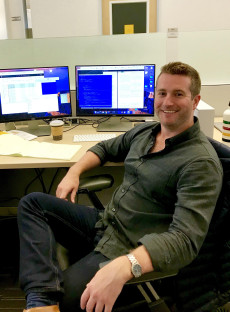CRD Post-doc Goes from Medical Devices to Mars Landing
Working on Pattern Recognition Software for NASA
June 15, 2018
Cleighton Roberts, cleightonroberts@lbl.gov
Applied mathematician Mike MacNeil joined the Computational Research Division’s (CRD) Analytics and Visualization group at Berkeley Lab as a postdoctoral researcher in August 2017, where he is developing new methods and software tools to help scientists improve their understanding of voluminous and complex, time-varying 3D image-based data acquired by experiments run at Berkeley Lab’s Advanced Light Source (ALS).
After getting a Ph.D. in Applied Math at the University of Edinburgh, MacNeil took a postdoctoral position at the University of Toronto’s Department of Medical Imaging. There he worked with Synaptive Medical, a medical imaging company focused on neurosurgery, to design algorithms for processing imaging data gathered from optics devices used in medicine. This is where he became more familiar with programming in languages like Python and C++.
With CRD he is doing a similar task, except this time he is applying it to images of carbon fiber weaves produced by NASA and acquired at the ALS (some NASA scientists are also ALS users). The properties of the weaves will determine resilience of a heat-shield made from them, which will be used to protect capsules that will land on Mars (NASA is also testing parachutes similar to those used in the 2012 Mars landing). To improve the weave and materials used in the heat-shield, they must thoroughly analyze the carbon fiber structures and create models about how it can deform and tear. In order to do this, they take thousands of zoomed-in photos using a 3D x-ray microscope, focusing on describing microscopic deformations. For example, they need to inspect that data to find structures that are characteristic of these fiber samples, a task that can be extremely time consuming.
This is where MacNeil comes in. “It is hard for a person to manually analyze this volume of images,” he said. “The idea is to offload part of the analysis to a machine.” To do this, he is using machine learning to discern complex fiber geometry from large and often noise-laden 3D images and then, after determining the fiber’s geometry, apply new numerical approaches to quantify damage to the fibers in the weave. The process is similar to how digital cameras identify faces by using specific pattern detection to capture better results.
Currently MacNeil is in the initial stage of this collaboration with ALS scientists Harold Barnard and Dula Parkinson. He believes that future users of the carbon fiber classifier algorithms will need to only provide only minimal information--namely, coloring a few fibers in sample images--which is then used by machine-learning methods to discover complex 3D fiber weave geometry. Later the software should be able to recognize the image without the fibers being colored.
"Mike has done a great job learning how to speak the language of experimentalists and materials scientists and figuring out what is important to us and how he can adapt what he does to be most useful,” Parkinson says. “He is enthusiastic and positive too, and a lot of fun to work with."
MacNeil says he has enjoyed his time at the lab and is excited by how much the team has accomplished so far, including presenting a poster about this work at the 2018 Conference on Data Analysis, where the national labs display their projects involving computational science and data.
“We appreciate that Mike adapts quickly and is very dynamic, just like the data we must analyze,” says Daniela Ushizima, P.I. of the DOE Early Career Research Project project that sponsors MacNeil and this collaboration effort with NASA and ALS. Ushizima is a staff scientist in CRD and a senior data scientist at BIDS and is responsible for research in computer vision and machine learning at CRD.
Outside the lab, MacNeil enjoys running, pizza making and visiting the Bay Area’s numerous pizza restaurants.
About Computing Sciences at Berkeley Lab
High performance computing plays a critical role in scientific discovery. Researchers increasingly rely on advances in computer science, mathematics, computational science, data science, and large-scale computing and networking to increase our understanding of ourselves, our planet, and our universe. Berkeley Lab’s Computing Sciences Area researches, develops, and deploys new foundations, tools, and technologies to meet these needs and to advance research across a broad range of scientific disciplines.







 Instagram
Instagram YouTube
YouTube